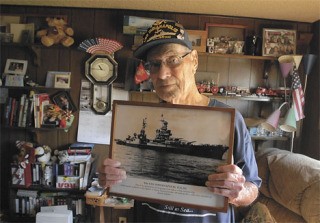When Eugene Morgan opened his small South Seattle home to me last year, he revisited a horrible chapter in his life.
At 87 and in failing health, the Navy veteran was more than willing to talk about a terrible episode at sea. It was therapeutic, he admitted, a psychological release from the fears that haunted him.
“For many years, I never discussed it,” he said. “I was too preoccupied in my work to relive it.
“I was fine until I retired. Then my mind wandered. Books and (TV) programs started to come out. … I was often reminded.
“To this day, I cannot look deep into the Puget Sound waters for any length of time.”
Morgan is forever linked to World War II history, part of the Navy’s most infamous ship sinking.
Yet he survived. Many of his friends and fellow crewmen did not.
Morgan, a 25-year-old master of arms officer, was aboard the ill-fated USS Indianapolis, an unescorted cruiser sunk by a prowling Japanese submarine in the Philippine Sea on July 30, 1945.
The torpedo attack killed about 300 of the 1,196 men on board. The rest of the crew, about 880 men, were tossed into the open sea. In the ensuing four days, those numbers dwindled as men succumbed to exposure, dehydration and injuries – and were pulled under and carried away by feasting, insidious sharks.
“You never knew when the sharks would attack, but you heard the screams when they did,” Morgan recalled. “You never forget those screams.”
But through it all, Morgan – more experienced than his younger adrift comrades – never lost faith. Help would come, he told himself. He would cling to his raft and hope for a rescue.
Of the 321 crew members rescued from the waters, 317 ultimately survived.
Morgan was lucky. He would eventually return home, marry his sweetheart and raise a large family. He would follow in his father’s footsteps and become a fireman.
“I enjoy life every day,” he said. “I enjoy it all.”
Morgan, the sailor, survivor, father and fireman, died in June of a heart attack.
Even in his final years on Earth, Morgan often spoke publicly about his experiences. He even appeared at a forum in Auburn last year to recount the tragedy, part of the city’s Veteran Days observance and memorial activities.
But while Morgan often told his story, his life never found complete closure – until recently.
This past week, Navy Machinist Mate 1st Class Jason Witty, of Puyallup, officially laid his grandfather to rest.
When the submarine USS Ohio surfaced in the South Pacific, Witty emerged from the hatch. He looked around, observed and stood in silence on deck. He held a silver pitcher, containing the ashes of the sailor who survived the unimaginable near these placid, western Pacific Ocean waters 63 years ago.
He knelt, poured and gave the ashes to the wind.
It was closure, a last wish from a man who served, sacrificed and died honorably. At long last, Morgan had rejoined his shipmates lost but not forgotten at sea.
“I knew he was in the war, in the Navy, but he never really talked about it until after my grandmother died,” Witty told The Associated Press. “One day I just got up the courage and he told me the story.”
A significant story that gives pause, and a lasting tribute to a fellow veteran.
Mark Klaas can be reached at 253-833-0218, ext. 5050, or mklaas@reporternewspapers.com


